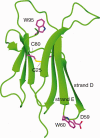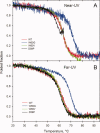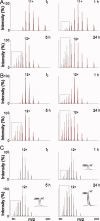DE-loop mutations affect beta2 microglobulin stability, oligomerization, and the low-pH unfolded form
- PMID: 20506535
- PMCID: PMC2974830
- DOI: 10.1002/pro.419
DE-loop mutations affect beta2 microglobulin stability, oligomerization, and the low-pH unfolded form
Abstract
Beta2 microglobulin (beta2m) is the light chain of class-I major histocompatibility complex (MHC-I). Its accumulation in the blood of patients affected by kidney failure leads to amyloid deposition around skeletal joints and bones, a severe condition known as Dialysis Related Amyloidosis (DRA). In an effort to dissect the structural determinants of beta2m aggregation, several beta2m mutants have been previously studied. Among these, three single-residue mutations in the loop connecting strands D and E (W60G, W60V, D59P) have been shown to affect beta2m amyloidogenic properties, and are here considered. To investigate the biochemical and biophysical properties of wild-type (w.t.) beta2m and the three mutants, we explored thermal unfolding by Trp fluorescence and circular dichroism (CD). The W60G mutant reveals a pronounced increase in conformational stability. Protein oligomerization and reduction kinetics were investigated by electrospray-ionization mass spectrometry (ESI-MS). All the mutations analyzed here reduce the protein propensity to form soluble oligomers, suggesting a role for the DE-loop in intermolecular interactions. A partially folded intermediate, which may be involved in protein aggregation induced by acids, accumulates for all the tested proteins at pH 2.5 under oxidizing conditions. Moreover, the kinetics of disulfide reduction reveals specific differences among the tested mutants. Thus, beta2m DE-loop mutations display long-range effects, affecting stability and structural properties of the native protein and its low-pH intermediate. The evidence presented here hints to a crucial role played by the DE-loop in determining the overall properties of native and partially folded beta2m.
Figures





Similar articles
-
Assessing the effect of D59P mutation in the DE loop region in amyloid aggregation propensity of β2-microglobulin: A molecular dynamics simulation study.J Cell Biochem. 2018 Jan;119(1):782-792. doi: 10.1002/jcb.26241. Epub 2017 Jul 31. J Cell Biochem. 2018. PMID: 28657666
-
Characterization of β2-microglobulin conformational intermediates associated to different fibrillation conditions.J Mass Spectrom. 2011 Aug;46(8):734-41. doi: 10.1002/jms.1946. J Mass Spectrom. 2011. PMID: 21766392
-
The effects of an ideal beta-turn on beta-2 microglobulin fold stability.J Biochem. 2011 Jul;150(1):39-47. doi: 10.1093/jb/mvr034. Epub 2011 Mar 11. J Biochem. 2011. PMID: 21398368
-
Molecular interactions in the formation and deposition of beta2-microglobulin-related amyloid fibrils.Amyloid. 2005 Mar;12(1):15-25. doi: 10.1080/13506120500032352. Amyloid. 2005. PMID: 16076607 Review.
-
From chance to frequent encounters: origins of beta2-microglobulin fibrillogenesis.Biochim Biophys Acta. 2005 Nov 10;1753(1):92-9. doi: 10.1016/j.bbapap.2005.09.002. Epub 2005 Sep 22. Biochim Biophys Acta. 2005. PMID: 16226064 Review.
Cited by
-
Structure, stability, and aggregation of β-2 microglobulin mutants: insights from a Fourier transform infrared study in solution and in the crystalline state.Biophys J. 2012 Apr 4;102(7):1676-84. doi: 10.1016/j.bpj.2012.02.045. Epub 2012 Apr 3. Biophys J. 2012. PMID: 22500768 Free PMC article.
-
Insights into the effects of N-glycosylation on the characteristics of the VC1 domain of the human receptor for advanced glycation end products (RAGE) secreted by Pichia pastoris.Glycoconj J. 2019 Feb;36(1):27-38. doi: 10.1007/s10719-018-09855-x. Epub 2019 Jan 5. Glycoconj J. 2019. PMID: 30612271
-
Understanding the complex mechanisms of β2-microglobulin amyloid assembly.FEBS J. 2011 Oct;278(20):3868-83. doi: 10.1111/j.1742-4658.2011.08186.x. Epub 2011 Jun 13. FEBS J. 2011. PMID: 21595827 Free PMC article. Review.
-
Platelet-derived β2M regulates monocyte inflammatory responses.JCI Insight. 2019 Mar 7;4(5):e122943. doi: 10.1172/jci.insight.122943. eCollection 2019 Mar 7. JCI Insight. 2019. PMID: 30702442 Free PMC article.
-
A simulated intermediate state for folding and aggregation provides insights into ΔN6 β2-microglobulin amyloidogenic behavior.PLoS Comput Biol. 2014 May 8;10(5):e1003606. doi: 10.1371/journal.pcbi.1003606. eCollection 2014 May. PLoS Comput Biol. 2014. PMID: 24809460 Free PMC article.
References
-
- Floege J, Ehlerding G. Beta-2-microglobulin-associated amyloidosis. Nephron. 1996;72:9–26. - PubMed
-
- Menaa C, Esser E, Sprague SM. Beta2-microglobulin stimulates osteoclast formation. Kidney Int. 2008;73:1275–1281. - PubMed
-
- Drueke TB. Beta2-microglobulin and amyloidosis. Nephrol Dial Transplant. 2000;15(Suppl 1):17–24. - PubMed
-
- Gejyo F, Yamada T, Odani S, Nakagawa Y, Arakawa M, Kunitomo T, Kataoka H, Suzuki M, Hirasawa Y, Shirahama T, Cohen AS, Schmid K. A new form of amyloid protein associated with chronic hemodialysis was identified as beta 2-microglobulin. Biochem Biophys Res Commun. 1985;129:701–706. - PubMed
Publication types
MeSH terms
Substances
LinkOut - more resources
Full Text Sources
Research Materials

